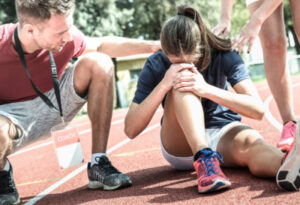As the industry leader in performance enhancement, we will continue to deliver a positive training experience that improves speed of movement and strength in character regardless of ability or economic status.

Injuries are a part of sport. There is no question about it. No matter how well you prepare for your sport, there is a risk that you will get injured during your season.
The dilemma is; what we’re doing in youth sports training helping or hurting our cause?
In the US 45% of athletes 12-14 years old specialize in one sport
A multifaceted resistance training program that begins in the preseason and includes instruction on movement biomechanics may reduce the risk of injury.
One third of youth coaches have never been trained in any sort of sport performance
Injuries are a part of sport, but a multifaceted training program can reduce the risk of injury. For the most part sport coaches are not trained to implement or create a strength program to reduce injury, or improve athletic performance. This isn’t a negative view of coaches, it’s realizing that they are different jobs. At the highest levels, college and professional coaches are not also providing the sport performance training. They are focusing on the game itself.
If an athlete is specializing in one sport at a young age they are not getting a diverse training environment. This means that the motor learning and tissue development is not well rounded; they may be getting skilled in their one sport, but without a broad range of development, other qualities high level athletes possess are not being developed. Competitive sports are a very dynamic environment, without a broad base of athletic development, an athlete is at a disadvantage in their sport and at an increased risk of injury.
There are many reasons to want to keep your athlete from experiencing injury. I think one of the most important is that athletes who have experienced significant injury, do not return to their sport. (In a study of 687 ACL surgeries, only 44% returned to their sport.)
This paints a somewhat bleak picture, as we’ve already discussed that injuries are a part of sport and we can’t totally eliminate them. But, there are things we can do to decrease the likelihood of injury, especially considering that of the 687 ACL surgeries referenced above, the vast majority of them – 518 of them – were non-contact injuries. While contact injuries are more difficult to predict or prevent, non-contact injuries can be mitigated with strength and biomechanics training.
The fact that sleep is number one on this list and not a fancy training modality is important. Adolescent athletes need between 8-10 hours of sleep each night.
“The strongest predictors of sports injuries in adolescents are insufficient sleep and higher age/grade. The research showed that 65% of those students getting less than 8 hours of sleep at night had injuries. This is a 1.7 times greater risk of injury than those teenagers getting more than 8 hours of sleep.” (Reference)
A balanced strength training program improves the body’s ability to not only produce, but to withstand forces. When done properly, it also improves biomechanics of the athlete so that the stress causing injuries are lessened.
Increasing training volume by more than 5% per week leads to an increased number of injuries. Simply, this means if you jump from 45-60 minutes of shooting hoops in the back yard a couple times per week to 1.5-2 hours of competitive practice every day, an athlete is at a higher risk of injury.
For a developing athlete, a well rounded approach is essential – There is no “One Thing” that will make an athlete perform better or reduce the risk of injury. There is nothing we can do to completely eliminate injury risk. But, by ensuring proper sleep, implementing a strength training program and appropriately progressing the training demands of a sport, we can reduce the frequency and severity of athletic injuries.
Was this content helpful? Give it a share:
Sign up for our newsletter and get caught up on all things happening right here at Parisi Speed School TC. Schedules, programs, and more!
As the industry leader in performance enhancement, we will continue to deliver a positive training experience that improves speed of movement and strength in character regardless of ability or economic status.
Subscribe to Parisi Newsletter and receive notifications on training, programs, and more!